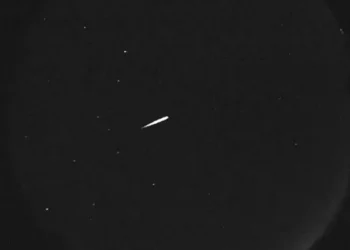A Chile-based telescope has captured a sweeping new image of the Butterfly Nebula, offering one of the clearest looks yet at a stellar remnant sculpted by a dying star. Released by the National Science Foundation’s NoirLab, the observation highlights how advanced ground-based telescopes continue to deepen our understanding of the Milky Way’s more dramatic celestial structures.
The photograph, taken last month by the Gemini South telescope in northern Chile, showcases the nebula’s glowing, wing-like lobes of gas. The object sits roughly 2,500 to 3,800 light-years away in the constellation Scorpius. Its vast, symmetrical form is the result of a star shedding its outer layers—an event that generates some of the most visually striking sights in astronomy.
A vibrant cosmic scene shaped by a dying star
The Chile telescope discovery provides a detailed look at a classic bipolar nebula, a category defined by lobes of gas extending in opposite directions from a central star. At the heart of this structure lies a compact white dwarf, once a Sun-like star that reached the end of its life cycle.
After exhausting its nuclear fuel, the star expelled large portions of its outer atmosphere into space. These gases now form the luminous “wings” that give the Butterfly Nebula its name. Gas clouds glow when heated by strong ultraviolet radiation from the central stellar core, creating a layered, colorful pattern visible in the new image.
Planetary nebulae like this one represent a fleeting phase in a star’s evolution, lasting only a few tens of thousands of years—brief moments on cosmic timescales. Stargazers and astronomers value these objects for their ability to reveal how stars disperse heavy elements that eventually seed new generations of stars and planets.
Gemini South marks 25 years of shared sky-watching
The image was taken as part of a special initiative celebrating 25 years of the International Gemini Observatory, which operates twin telescopes in Hawaii and Chile. Schoolchildren in Chile were invited to help select the observation target, choosing the Butterfly Nebula from a range of astronomical candidates.
Researchers at NSF’s NoirLab said the project was designed not only to showcase the observatory’s capabilities but also to highlight how science education programs can connect communities with discoveries taking place just beyond the visible night sky.
Gemini South, located on Cerro Pachón in the Andes, benefits from exceptionally clear atmospheric conditions and advanced adaptive optics. The instrument is part of a global network of ground-based telescopes supporting research across stellar evolution, exoplanet discovery, galaxy formation, and transient cosmic events.
A growing collection of nebular portraits
The Butterfly Nebula, officially designated NGC 6302, is known for its dramatic structure and extreme temperatures. Earlier studies suggest that the central white dwarf may exceed 200,000 degrees Celsius, making it one of the hottest stars known. Though invisible in the latest wide-field image, its influence shapes the nebula’s intricate arcs and filaments.
This new portrait adds to a growing gallery of detailed nebular images produced by observatories around the world. Similar efforts include the European Southern Observatory’s views of the Ant Nebula and NASA’s Hubble Space Telescope observations of the Cat’s Eye Nebula. Each reveals different stages and structures that arise when aging stars eject their outer layers.
Astronomers study these objects to understand how stellar winds interact with previously expelled shells of gas, forming patterns that vary from hourglass shapes to ring-like halos and complex knots. The Butterfly Nebula is considered one of the most symmetrical examples, making it a frequent target for both professional research and public outreach.
Why these discoveries matter
Beyond their visual appeal, nebula observations help researchers refine models of star formation and chemical enrichment across the galaxy. Gas expelled in the final stages of a star’s life contains elements such as carbon, nitrogen, and oxygen—building blocks for planets, atmospheres, and organic chemistry.
Detailed imaging also allows scientists to examine the speed and direction of nebular expansion. In some cases, planetary nebulae reveal evidence of binary star interactions, stellar outbursts, or asymmetrical winds that shape the surrounding material.
Though this latest image does not alter existing scientific theories, it demonstrates how modern optical facilities continue to enhance the clarity, color range, and precision of deep-sky photography. Observatories in Chile, including Gemini South and the forthcoming Vera C. Rubin Observatory, are expected to play an increasingly central role due to ideal conditions in the Atacama and Andean regions.
A public moment for a scientific milestone
For many astronomers, the picture represents a bridge between the observatory’s 25-year legacy and the next generation of scientific exploration. For the Chilean students who helped select the target, it transformed a distant astrophysical concept into something real and vividly bright.
The release offers a reminder of how human curiosity often intersects with advanced instruments to reveal the hidden structures of the cosmos. Even familiar objects such as the Butterfly Nebula can appear renewed when viewed through improved lenses and fresh eyes—proving that the night sky still holds surprises, even in well-charted constellations.
As Gemini South continues its observations, researchers say they expect more opportunities to combine scientific discovery with educational outreach, ensuring that public engagement remains an integral part of modern astronomy.
This article was rewritten by JournosNews.com based on verified reporting from trusted sources. The content has been independently reviewed, fact-checked, and edited for accuracy, neutrality, tone, and global readability in accordance with Google News and AdSense standards.
All opinions, quotes, or statements from contributors, experts, or sourced organizations do not necessarily reflect the views of JournosNews.com. JournosNews.com maintains full editorial independence from any external funders, sponsors, or organizations.
Stay informed with JournosNews.com — your trusted source for verified global reporting and in-depth analysis. Follow us on Google News, BlueSky, and X for real-time updates.











